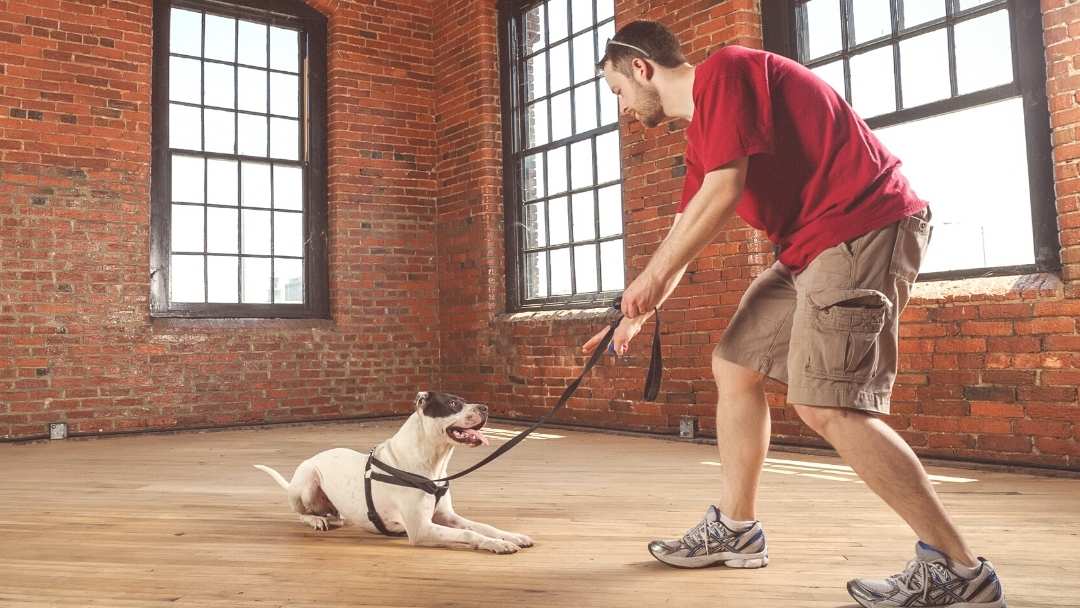
[Episode 17]
Do Bootcamp Dog Training Programs Work?
The 5 things you need to know before you send your dog to bootcamp
I got an email from a nice lady that had just watched the Free Dog Training Masterclass that leads to our two amazing online programs. She said, I paid for an expense bootcamp and it didn’t work for my dog. How do I know your program will work because I can’t afford to waste any more money?
It didn’t shock me to learn that she had sent her dog to an expensive boot camp training program and had not seen the results she hoped for. She also shared that they used a shock collar on her dog during his bootcamp and not only do shock collars not work, they can and often do, make your dog worse. So do you know IF you should send your dog to bootcamp?
It’s tempting to think that you send your dog away for 3 weeks, $4000, and get a perfect dog that won’t run in the street and listens 100% of the time, but is that a reality?
The first thing you need to do is educate yourself so that you don’t waste money like that struggling dog mom that emailed me.
There are 5 things that you need to know before you send your dog away to a boot camp training program.
Aside from veterinary care, how you train your dog is the single most important decision you’ll make for your dog.
1. How are they going to train your dog?
Dog Training is Unregulated. That means that anyone can call themselves a “dog trainer” without any previous experience or education.
You need to find know who is this person that’s going to train your dog or this facility? Are they certified? Where were they educated?
And more importantly, how are they going to train your dog? Specifically, you need to ask, how do they get behavior? You need to specifically ask, will you be using a shock collar? Will you use a prong collar? Will you use a choke chain? Or will you be using food or a hundred percent positive reinforcement?
A good place to start is with their social media account. Nowadays every trainer and every facility should have a social media account. And you want to go on there and look at their videos, not just photos. You want to look for videos of how they are actually training the dog. Don’t look at the before and after, that doesn’t give you enough information. You need to see HOW they’re getting the dog to listen. I share actual training lessons on my Instagram account. There are unedited videos of exactly how I teach and train. Many times, I give the videos to my clients so they can remember what to do. I share them for inspiration for you and so that you can see how I get the dog to listen.
The American Veterinary Society of Animal Behavior does not recommend that you train your dog using a shock collar, a prong collar, a choke chain, or any kind of leash corrections.
The training methods that you should look for should employ humane modern force-free techniques that come from a place of compassion and be backed by current research in the area of animal learning.
Animal behavior is 100% science-based on Operant Conditioning and classical conditioning. You can look up those two words. Most dog trainers only focus on teaching dogs commands like sit, stay, come and punish a dog when he doesn’t listen. That one part of Operant Conditioning (it’s not all of it).
Most uninformed dog trainers don’t understand Classical Conditioning, which is where dogs learn emotions, such as fear, anxiety, stress, and so on. Your dog has emotions and how you train your dog weighs heavily on the emotions of your dog.
You do not want to send your dog to a boot camp program or a board and train program that’s going to use a shock collar, a prong collar, or a choke chain. In the episode, I share a story about a dog named Snickers that was sent to 2 different bootcamp programs. Both used a shock collar and Snickers developed aggression as a result. Unfortunately, the damage could not be undone and the family didn’t want to spend more money on training. They had already spent around $8,000.
Training should employ humane, modern, force-free techniques, and come from a place of compassion, and be backed by current research in the area of learning and animal behavior too.
2. You’re not building trust with your dog when someone else is training your dog.
The human-animal bond is important. We’ve all seen those videos where the soldier comes home and the dog goes crazy with excitement to see his human or when a lost dog is reunited with his human.
Your dog trusts you to know how he communicates and when he’s uncomfortable. And one of the biggest mistakes I see struggling dog owners make is thinking that their dog thinks like them. Your dog is not a mini human. He thinks and learns differently than you and you owe it to him to learn about him. It won’t take you very long and most people love learning about dog body language and how their dog is feeling in a given circumstance.
Snickers, the dog I told you about above, had a bite history. In order to work with him, I had to earn his trust. I couldn’t just walk in and expect that he would trust me automatically.
3. You’re not learning how your dog communicates
Many people make the mistake of waiting for their dog to growl or snap to see if he’s uncomfortable, but your dog will tell you at least 12x that he’s uncomfortable before he growls or snaps. You won’t learn how your dog communicates when he’s in a bootcamp. We go over this in both of our online programs because it is so important. In the program, I share the Ladder of Aggression. This illustration shows how dog communication progresses when the subtle signs are ignored. As humans we’re not born knowing how dogs communicate, we have to learn. I find that most dog moms and dads love learning about dog body language.
4. Dogs don’t automatically generalize what they learn
If your dog learns, sit, stay or come at the training facility, he’s not going to know it at your house. This was a sad reality I learned when I worked at the daycare training dogs in our board and train program. The dog would listen and do well in the facility, but when the person would report back and say the dog wasn’t listening at home. This is because dogs don’t automatically generalize what they learn. They also don’t generalize between people. If I teach your dog to Go to Bed, and then you come pick him up, take him home and say, Go to Be, he won’t do it. You have to teach your dog in different places, almost starting from the beginning. The more you practice, the quicker your dog will generalize. It’s important to remember that dogs are not humans. They don’t learn exactly the same way we do and it’s not fair to expect them too.
5. Behavior is influenced or caused by the environment.
I’m going to use reactivity (lunging and barking at dogs) as an example.
Many people make the mistake of thinking that the dog is protecting their home because they might be more reactive in their neighborhood and less reactive if they take them and walk him at the park. That happens because the dog practices the reactive behavior more around his home (because you walk your dog more in your neighborhood) than at the park. Your dog will become reactive at the park if you walk him there enough and he gets comfortable.
Because reactivity is based on fear, where your dog experiences more fearful things comes into play with training. Your dog will always be more reactive closer to home, because that’s where you walk him most of the time.
The moral of the story is that there are no quick fixes. We’re all busy with work, the kids, making it to the gym every day…who has time to train the dog. But you need to make time. A dog is a responsibility, and a responsibility that you chose. It was your decision to get a dog and it was a great decision, but it requires time and commitment on your part.
Training is a lifelong experience. It’s a journey. You’ve got this, you can do it! And you’re going to love it!
Follow us on Instagram to see our daily training lessons. You’ll learn a lot and get a dog that listens.


FREE MASTERCLASS
3 STEPS TO GET YOUR DOG TO LISTEN
Most struggling dog owners spend hours watching videos and reading blog posts that don’t address the cause of their problem. They waste time focusing on the symptoms and then think their dog is difficult or can’t change when they don’t see results. If you’re ready to finally see change, then sign up and watch this FREE Masterclass.

